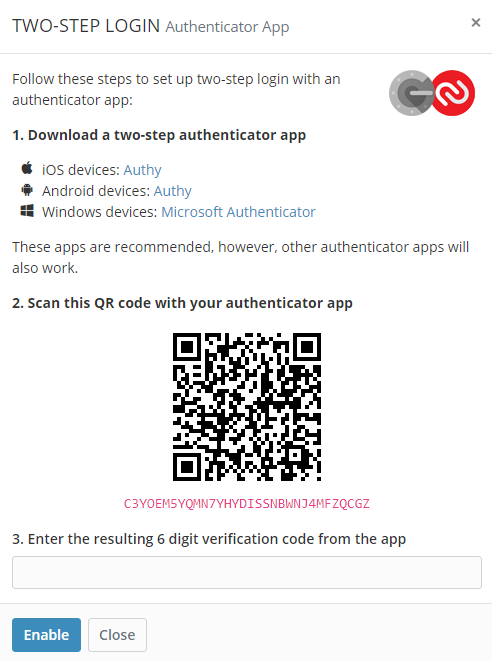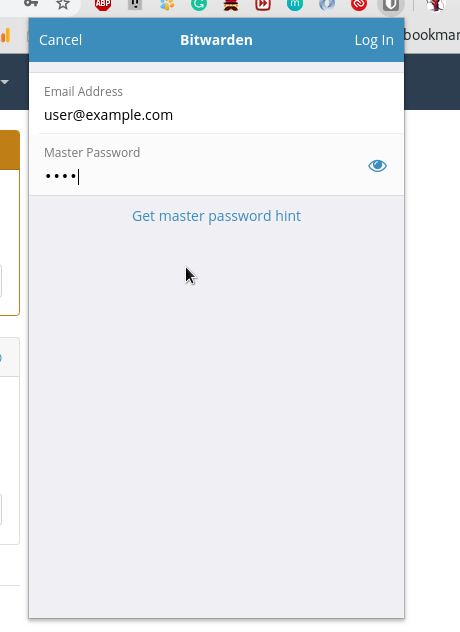
© Provided by TechRepublic Image: Jack Wallen
Bitwarden is the easiest and safest way to store all of your logins and passwords while conveniently keeping them synced between all of your devices. Password theft is a serious problem. The websites and apps that you use are under attack every day. Security breaches occur and your passwords are stolen.
Cost of hosting bitwarden in AWS EC2? Has anyone been running a 24x7 EC2 instance to self-host bitwarden? Looking to see what the cost would be. In this post, Bitwarden will be installed on an AWS EC2 instance with additional EBS volume mounted to /bitwarden where Bitwarden will store its data and which will be backed up by AWS Data Lifecycle Manager. On the EC2 will have NGINX running as a frontend and SSL sessions with a certificate from Let’s Encrypt will be terminated here.

My two favorite parts about BitWarden: There is a self-host option, and the project is open source. There are a number of different open source implementations of various aspects of the project, which is awesome. I decided to deploy my self-hosted Bitwarden deployment in AWS. My first decision to make was “how should I host this?”. An alternative implementation of the Bitwarden API based on a AWS Serverless stack.
More about cybersecurity

The new Send tab of the Bitwarden password manager.
The developers of the Bitwarden password manager are always looking to improve their software. When their PR guys reached out to me last week to let me know of a new feature, you can bet I was all ears. Said feature isn't a deal maker or breaker, but for some, it could fill a void found in many desktop and mobile password manager apps. That void is sharing passwords, text and files securely.
Consider this: you have a password that you frequently have to share out with others. You use Bitwarden, so when the password is requested, you open the tool, search for the password, copy it, and paste it into a message. First, that's a lot of steps. Second, is your method of sending secure? After all, you are sending a password to a (possibly) critical service.
What do you do?
If you're using the latest version of Bitwarden (either on the desktop or your mobile device), you could simply create a new Send so it's always at the ready. With the new Bitwarden software, you can create either text or file-based Sends.
Let me show you how this works.
SEE: Identity theft protection policy (TechRepublic Premium)
What you'll need
To make this work you'll need the latest version of Bitwarden (1.25.0). To send Files, you'll need a Premium license, which is $10/yearly. I'm going to demonstrate on the desktop client, but the process is the same on the mobile version. To make this feature even better, all of your Sends will sync between clients--as long as they are associated with the same Bitwarden account.

How to create a Send
Open Bitwarden. In the new interface, you'll see a Send tab at the bottom of the left pane (Figure A).
Figure A
© Provided by TechRepublic The new Send tab of the Bitwarden password manager.Click on the Send button and click +. At the top of the new window, select either File or Text (Figure B). Just remember, to send a file, you must have a Premium account.
Figure B
© Provided by TechRepublic The new Send add window is simple to fill out.Let's say you want to create a Send for a password that you frequently have to share out with other staff members. Give the new Send a name, select Text, and then copy the password in the text field. Once you've done that, scroll down to the Options section and set a Deletion Date for the Send link (Figure C). This is important, as you don't want that link permanently valid.
Figure C
© Provided by TechRepublic Setting the Send options in Bitwarden.
You can also set an expiration date and a max access count (how many times a user can access the send before it becomes inaccessible).
Scroll down again and create an optional password and add any notes you might want/need for the Send (Figure D).
Figure D
© Provided by TechRepublic Setting a password for the new Send in Bitwarden might ease your concern about a third-party viewing the text.If you do set a password for the Send, you'll need to share the password with the recipient, but gaining that extra layer of security might be worth the added steps.
Click the checkbox for Copy The Link To Share This Send To My Clipboard Upon Save and click the Save button at the bottom of the window. You can now paste the Send link into an email or a message and send it to the recipient.
That's all there is to using the new Bitwarden Send feature.
Nits to pick
Of all the password managers out there, Bitwarden is my favorite. Besides being open source, Bitwarden also has the perfect ratio of features and simplicity. That ease of use is one of the reasons why I found a few nits to pick with the new Send option.
Because Bitwarden is such an easy tool to use, it surprises me that they don't have a more fully-realized sharing option built into the tool. Instead, you must opt to use an external tool to share the Send link. This leads me to my other nit: why not make it possible to quickly share an entry in the Vault?
Add a share option that would allow you to create a link to share a login entry from within your Bitwarden Vault. All you'd have to do is locate the entry to be shared and click the Share button. Fill out an email address and an encrypted link is automatically sent to the recipient.
That, of course, might be asking for too much. Given how well Bitwarden development has gone, I'd say it's a feature that should be under consideration.
Either way, if you're not already using a password manager, you owe it to yourself (and your company) to start using one. Why not go with the best in breed and use Bitwarden?
Subscribe to TechRepublic's How To Make Tech Work on YouTube for all the latest tech advice for business pros from Jack Wallen.
Also see
- How to become a cybersecurity pro: A cheat sheet (TechRepublic)
- Social engineering: A cheat sheet for business professionals (free PDF) (TechRepublic)
- Shadow IT policy (TechRepublic Premium)
- Online security 101: Tips for protecting your privacy from hackers and spies (ZDNet)
- Cybersecurity and cyberwar: More must-read coverage (TechRepublic on Flipboard)
Bitwarden(opens new window) is an open-source password management solution for individuals, teams, and business organizations.
🔑 Credentials
You can find authentication information for this node here.
# Basic Operations
- Delete a collection
- Get a collection
- Get all collections
- Update a collection
- Get all events
- Create a group
- Delete a group
- Get a group
- Get all groups
- Get members of a group
- Update a group
- Update members of a group
Bitwarden Aws Lambda
- Create a member
- Delete a member
- Get a member
- Get all members
- Get groups of a member
- Update a member
- Update groups of a member
# Example Usage
This workflow allows you to create a group, add members to the group, and get the members of the group in Bitwarden. You can also find the workflow(opens new window) on n8n.io. This example usage workflow would use the following nodes.
The final workflow should look like the following image.
# 1. Start node
The start node exists by default when you create a new workflow.
# 2. Bitwarden node (create: group)
This node will create a new group called documentation in Bitwarden.
- First of all, you'll have to enter credentials for the Bitwarden node. You can find out how to do that here.
- Select 'Group' from the Resource dropdown list.
- Select 'Create' from the Operation dropdown list.
- Enter
documentationin the Name field. - Click on Execute Node to run the node.
In the screenshot below, you will notice that the node creates a new group in Bitwarden.
# 3. Bitwarden1 node (getAll: member)

This node will get all the members from Bitwarden.
- Select the credentials that you entered in the previous node.
- Select 'Member' from the Resource dropdown list.
- Select 'Get All' from the Operation dropdown list.
- Toggle Return All to
true. - Click on Execute Node to run the node.
In the screenshot below, you will notice that the node retrieves all the members from Bitwarden.
# 4. Bitwarden2 node (updateMembers: group)
This node will update all the members in the group that we created earlier.
- Select the credentials that you entered in the previous node.
- Select 'Group' from the Resource dropdown list.
- Select 'Update Members' from the Operation dropdown list.
- Click on the gears icon next to the Group ID field and click on Add Expression.
- Select the following in the Variable Selector section: Nodes > Bitwarden > Output Data > JSON > id. You can also add the following expression:
{{$node['Bitwarden'].json['id']}}. - Click on the gears icon next to the Member IDs field and click on Add Expression.
- Select the following in the Variable Selector section: Current Node > Input Data > JSON > id. You can also add the following expression:
{{$json['id']}}. - Click on Execute Node to run the node.
In the screenshot below, you will notice that the node updates the members of the group.
# 5. Bitwarden3 node (getMembers: group)
Bitwarden Authenticator (TOTP) | Bitwarden Help & Support
This node will get all the members in the group that we created earlier.
- Select the credentials that you entered in the previous node.
- Select 'Group' from the Resource dropdown list.
- Select 'Get Members' from the Operation dropdown list.
- Click on the gears icon next to the Group ID field and click on Add Expression.
- Select the following in the Variable Selector section: Nodes > Bitwarden > Output Data > JSON > id. You can also add the following expression:
{{$node['Bitwarden'].json['id']}}. - Click on Execute Node to run the node.
Bitwarden Aws Login
In the screenshot below, you will notice that the node retrieves the members in the group.
